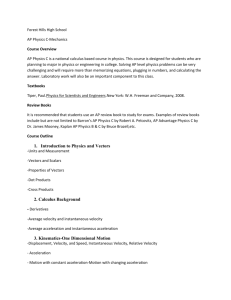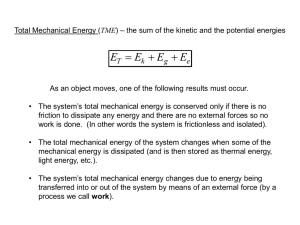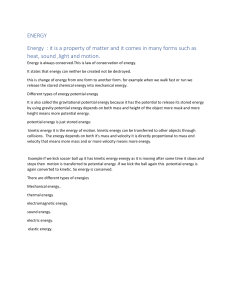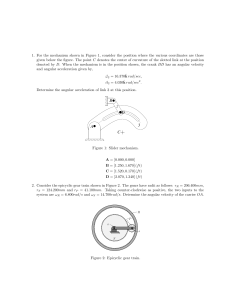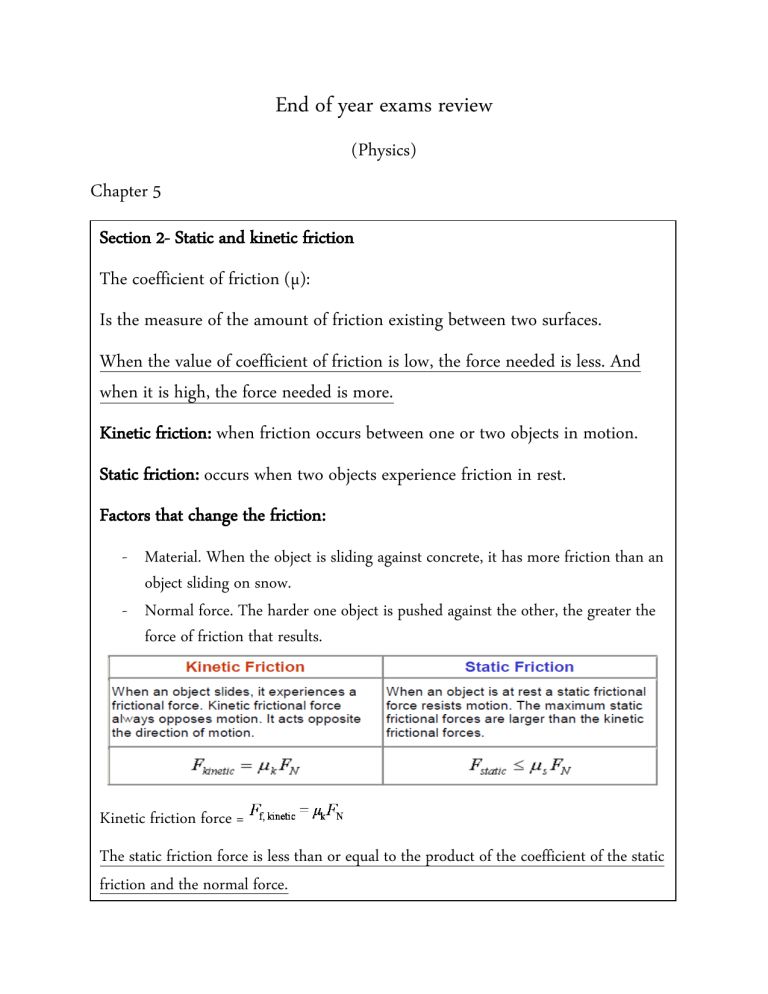
End of year exams review (Physics) Chapter 5 Section 2- Static and kinetic friction The coefficient of friction (µ): Is the measure of the amount of friction existing between two surfaces. When the value of coefficient of friction is low, the force needed is less. And when it is high, the force needed is more. Kinetic friction: when friction occurs between one or two objects in motion. Static friction: occurs when two objects experience friction in rest. Factors that change the friction: - Material. When the object is sliding against concrete, it has more friction than an object sliding on snow. - Normal force. The harder one object is pushed against the other, the greater the force of friction that results. Kinetic friction force = The static friction force is less than or equal to the product of the coefficient of the static friction and the normal force. Chapter 6 Section 1- Projectile motion Horizontally launched projectiles: - No horizontal acceleration - Horizontal velocity (vx) is constant. - The vertical acceleration equals -9.81 m/s2 𝑥𝑓 = 𝑣𝑡! + 𝑥" Vertically launched projectiles: 𝑣𝑓 = 𝑣𝑖 + 𝑎𝑡! 1 𝑥𝑓 = 𝑥𝑖 + 𝑣" 𝑡! + 𝑎𝑡! # 2 𝑣𝑓 # = 𝑣𝑖 # + 2𝑎(𝑥𝑓 − 𝑥𝑖) Velocity Acceleration Displacement Vertical motion (Y) Vi=0 Vf= Calculated A=-9.81 m/𝑠 ! 1 𝑦 = 𝑦𝑓 − 𝑦𝑖 = 𝑎! 𝑡 " 2 The time in both motions is the same. Horizontal motion (X) Vi=Vf=x/t A=0.0 m/𝑠 ! 𝑥 = 𝑣$ 𝑡 Section 2- Circular motion Uniform circular motion: -The movement of an object at a constant speed around a circle with fixed radius. Centripetal force Acts towards the center Centrifugal force Acts perpendicular to the centripetal force (outside) A real force Not a real force Can be caused by gravity, string, friction. etc. Caused by inertia Example: a ball attached to a string that is Example: a car moving in a straight path then moving in a circular motion. suddenly taking a curved turn. Similarity: both acts on objects that are moving in a circular motion. Centripetal force: 𝑣# 𝑎= 𝑟 4𝜋𝑟 # 𝑎% = 𝑇# According to newton’s second law: 𝑚𝑣 " 𝐹! = 𝑚𝑎! = 𝑟 𝑣" 𝑎! = 𝑟 Chapter 7 A change in momentum is the result of an impulse, which is the product of the average force and the time of the interaction. 1 1 𝐹𝑑 = 𝑚𝑣# " − 𝑚𝑣$ " 2 2 Work = constant force exerted on an object in the direction of motion (*) the object’s displacement. W = Fd So: % % " " 𝑊 = 𝑚𝑣# " − 𝑚𝑣$ " The SI unit of work is called a joule. One joule is equal to 1N•m. The equation holds true only for constant forces exerted in the direction of motion. • Recall from Newton’s laws that a perpendicular force does not change the speed of a system, only its direction. So when a force is exserted from a 90 degree angle, the work done is zero. 𝑊 = 𝐹𝑑 cos 𝜃 A graph of force versus displacement lets you determine the work done by a force; you can calculate the work by finding the area of the figure. Chapter 8 Section 1- Forms of energy Kinetic Energy: 1 𝐾𝐸 = 𝑚𝑣 " 2 Where m is the mass of the object and v is the magnitude of its velocity. The kinetic energy is proportional to both the mass and the square of the velocity. Rotational kinetic energy: -The kinetic energy of a spinning object. % 𝐾𝐸&'( = 𝐼𝜔" " Where I is the object’s moment of inertia and ω is the object’s angular velocity. Potential energy: -Energy that is stored due to interactions between objects in a system. 𝐺𝑃𝐸 = 𝑚𝑔ℎ g is the acceleration due to gravity. Gravitational potential energy, like kinetic energy, is measured in joules. The sum of kinetic energy and potential energy is always constant because no work is done on the system by any external forces. Elastic potential energy: - The stored energy due to an object’s change in shape, like the pulled string It is often stored in rubber balls, rubber bands, slingshots, and trampolines. Mass, by its very nature, is energy. This energy, E0, is called rest energy and is represented by the following famous formula. 𝐸 = 𝑚𝑐 ! It is the object’s mass times the speed of light squared. Section 2- Conservation of energy • The Law of conservation of energy states that in a closed, isolated system, energy can neither be created nor destroyed, energy is conserved. Mechanical energy: The sum of kinetic energy and potential energy of a system. Kinetic energy Translational and rotational kinetic energy. Potential energy Gravitational and elastic potential energy. Mechanical energy formula if no other forms of energy are present: 𝑀𝐸 = 𝐾𝐸 + 𝑃𝐸 Momentum Kinetic energy Elastic collision: Isolated system Conserved Not conserved Closed system Not conserved Conserved A collision in which the kinetic energy does not change. Inelastic collision: A collision where kinetic energy is not conserved, but instead converted to thermal energy. Super elastic (explosive) collision: A collision in which kinetic energy increased in a system. Momentum is conserved in a collision. Energy is conserved only in elastic collisions. Chapter 9 Section 1- Describing rotational motion. The radian: Is " !# of a revolution. One complete revolution is equal to 2p radians. • The counterclockwise rotation is designated as positive, while clockwise is negative. Angular displacement: The change in the angle when an object rotates. For rotation through an angle, θ, a point at a distance, r, from the center moves a distance given by: d = rθ Angular velocity: ∆𝜃 𝜔= ∆𝑡 Angular displacement divided by the time required to make the displacement. • Angular velocity is measured in rad/s. • For Earth, ωE = (2π rad)/[(24.0 h)(3600 s/h)] = 7.27×10─5 rad/s. If an object’s angular velocity is ω, then the linear velocity of a point at distance, r, from the axis of rotation is given by: 𝑣 = 𝑟𝜔 The speed at which an object on Earth’s equator moves because of Earth’s rotation is given by v = r ω = (6.38×106 m) (7.27×10─5 rad/s) = 464 m/s. The way that counterclockwise rotation produces positive d, it also has positive ω. Angular acceleration: ∆𝜔 ∆𝑡 Is the change in angular velocity divided by the time required to make that change. 𝛼= Angular acceleration is measured in rad/s2. • If the change in angular velocity is positive, then the angular acceleration is also positive. Angular frequency: The number of complete revolutions made by the object in 1 s. 𝑓 = $ !# Section 2- Rotational dynamitic. The change in angular velocity depends on: v The magnitude of the force. v The distance from the axis to the point where force is exerted. v Direction of the force. When the force is acting perpendicularly, the lever arm is the distance from the axis, but when it is not, then the lever arm is reduced. Torque: Is a measure of how effectively a force causes rotation. 𝜏 = 𝐹𝑟 𝑠𝑖𝑛𝜃 Torque is measured in newton-meters (N·m). Moment of inertia: The resistance of rotation, represented by the symbol I and has units of mass times the square of the distance. 𝐼 = 𝑚𝑟 " • Newton’s second law for rotational motion states that angular acceleration is directly proportional to the net torque and inversely proportional to the moment of inertia. 𝜏)*( 𝐼 If the torque on an object and the angular velocity of that object are in the same direction, then the angular velocity of the object increases, but if they are in different directions, it will decrease. 𝛼= Chapter 10 Section 2- Momentum and conservation. Under what conditions is the momentum of the system of two balls conserved? v Closed system: A system, which does not gain or lose mass. v Isolated system: The net external force on a closed system is zero. No system on Earth can be said to be isolated because there will always be some interactions between a system and its surroundings. The law of conservation of momentum states that the momentum of any closed, isolated system does not change. The equality of the momenta before and after the collision also means that the sum of the components of the vectors before and after the collision must be equal. Section 3- Equilibrium. center of mass of a distribution of mass in space (sometimes referred to as the balance point) is the unique point where the weighted relative position of the distributed mass sums to zero. 1. This is the point to which a force may be applied to cause a linear acceleration without an angular acceleration. 2. It is a hypothetical point where the entire mass of an object may be assumed to be concentrated to visualize its motion. Conditions for Equilibrium 1. An object is said to be in static equilibrium if both its velocity and angular velocity are zero or constant. 2. First, it must be in translational equilibrium; that is, the net force exerted on the object must be zero. 3. Second, it must be in rotational equilibrium; that is, the net torque exerted on the object must be zero. Centrifugal “force”: is an apparent force that seems to be acting on an object when that object is kept on a rotating platform. Coriolis “force”: is an apparent force that seems to cause deflection to an object in a horizontal motion when the observer is in a rotating frame of reference. 𝑣! 𝑎= 𝑟
